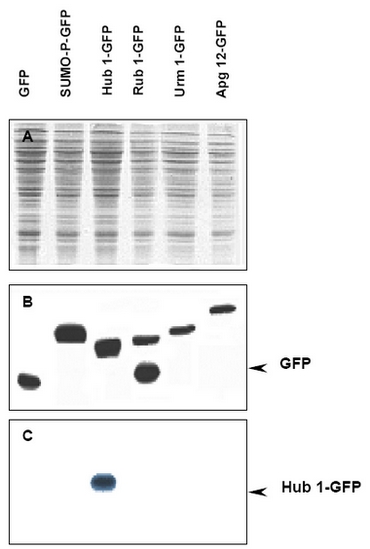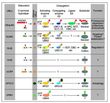HUB1 Rabbit Polyclonal Antibody
Other products for "HUB1"
Specifications
| Product Data | |
| Applications | ELISA, WB |
| Recommended Dilution | This purified polyclonal antibody reacts with yeast Hub1 by Western blot and ELISA. This antibody using the specified conditions may recognize other prominent intrinsic bands (UBLs or conjugates). Other intrinsic bands are readily detectable at lower dilutions. A 9.7 kDa band corresponding to yeast Hub1 is detected. Most yeast cell lysates can be used as a positive control without induction or stimulation. Recommended Dilutions: ELISA: 1/1,000-1/5,000. Western Blot: 1/500-1/2,000. Although not tested, this antibody is likely functional in Immunohistochemistry and Immunoprecipitation. |
| Reactivities | Yeast |
| Host | Rabbit |
| Clonality | Polyclonal |
| Immunogen | This purified antibody was prepared from rabbit serum after repeated immunizations with recombinant yeast Hub1 protein. |
| Specificity | Assay by immunoelectrophoresis resulted in a single precipitin arc against anti-Rabbit Serum. |
| Formulation | 0.02 M Potassium Phosphate, 0.15 M Sodium Chloride, pH 7.2 with 0.01% (w/v) Sodium Azide as preservative. State: Purified State: Lyophilized purified Ig fraction. |
| Reconstitution Method | Restore with 0.1 ml of deionized water or equivalent. |
| Concentration | lot specific |
| Purification | A multi-step process which includes Delipidation, Salt Fractionation and Ion exchange chromatography followed by extensive dialysis against the buffer stated below. |
| Conjugation | Unconjugated |
| Storage | Store vial at 2-8°C prior to restoration. For extended storage add glycerol to 50% and then aliquot contents and freeze at -20°C or below. Centrifuge product if not completely clear after standing at room temperature. This antibody is stable for one month at 2-8°C as an undiluted liquid. Dilute only prior to immediate use. Avoid repeated freezing and thawing. |
| Stability | Shelf life: One year from despatch. |
| Database Link | |
| Background | Ubiquitin-like proteins fall into two classes: the first class, ubiquitin-like modifiers (UBLs) function as modifiers in a manner analogous to that of ubiquitin. Examples of UBLs are SUMO, Rub1 (also called Nedd8), Apg8 and Apg12. Proteins of the second class include parkin, RAD23 and DSK2, are designated ubiquitin-domain proteins (UDPs). These proteins contain domains that are related to ubiquitin but are otherwise unrelated to each other. In contrast to UBLs, UDPs are not conjugated to other proteins. Hub1 ("Homologous to UBiquitin") may function as a modifier (see figure 2) but its role is unclear because it lacks the double glycine motif characteristic for ubiquitin and ubiquitin-like modifiers. Recently cell polarity factors Sph1 and Hbt1 have been identified as in vivo targets of Hub1 conjugation. HUB1 has close homologs in other species including humans. The human homologs is called Ubl5. |
| Synonyms | YNR032C-A |
| Reference Data | |
Documents
| Product Manuals |
| FAQs |
| SDS |
{0} Product Review(s)
0 Product Review(s)
Submit review
Be the first one to submit a review
Product Citations
*Delivery time may vary from web posted schedule. Occasional delays may occur due to unforeseen
complexities in the preparation of your product. International customers may expect an additional 1-2 weeks
in shipping.






























































































































































































































































 Germany
Germany
 Japan
Japan
 United Kingdom
United Kingdom
 China
China




